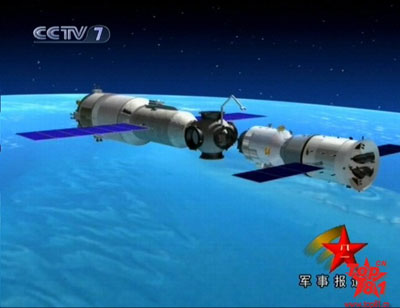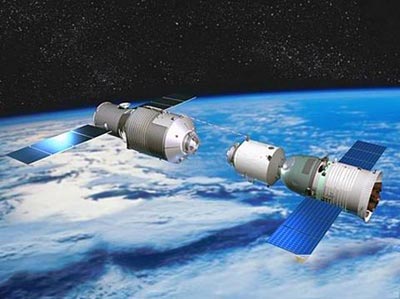Phasing Dragonby Dwayne A. Day
|
| Popular media reporting about China’s future space plans seems more to reflect Western biases and fears than it does what the Chinese government is actually saying and doing. |
Take two examples. The first is a March 2 article that appeared on Spaceflight Now titled “China readies military space station – launch coincides with shuttle phaseout.” The article, by veteran space reporter Craig Covault, reported that China is developing a new, small, man-tended space station named Tiangong-1 that will be launched in 2010 and visited by multiple Shenzhou manned spacecraft over the next several years. It also reported that, in addition, China is developing a much larger Mir-class space station to be launched by 2020. The article also stated that Tiangong-1 will have at least a partial military mission and compared it to the American Manned Orbiting Laboratory program developed during the 1960s but canceled before a single launch.
The next day, Aviation Week carried a blog post from veteran space entrepreneur Jeff Manber titled “China’s Space Station May be Signal to NASA.” Manber asked why the Chinese were now making such an announcement. One explanation may be that the demise of their lunar probe was a perfect opportunity to indicate their future plans. But Manber suggested a different explanation, writing that it may be “a careful signal that now is the time to engage on cooperation over the International Space Station. In a year or so, it may be too late to invite China onto the ISS, and China’s own requirements may be too onerous for the ISS partnership.” In January 2008 Manber wrote a thought-provoking op-ed piece about US-China space cooperation, so he is not new to the subject.
Neither article is factually inaccurate, but both failed to recognize that China’s “announcement” of the Tiangong-1 plans is really only a minor amplification of information that the Chinese released last fall—it is not really new information, or a change in Chinese openness in order to achieve some kind of international agenda. A speaker at the annual International Astronautical Federation conference held in Glasgow, Scotland in September spoke about China’s future human spaceflight plans, including the stepping-stone approach to development of a full space station capability, the Tiangong-1 plan, and the eventual development of a Mir-like large space station. That talk was discussed in The Space Review in early October (see “The new path to space: India and China enter the game”, The Space Review, October 13, 2008).
The presentation in September (which can be downloaded here) corrected one assumption made by western observers about China’s space plans. Instead of a linkup of two manned Shenzhou craft, the Chinese were planning on launching a small unmanned module—Tiangong-1—and then rendezvousing with it using an unmanned Shenzhou spacecraft. The first rendezvous event, involving Shenzhou 8, would probably not involve any crew, but would be followed by several visits involving human crews. As announced nearly six months ago, between 2010 and 2015 the Chinese might launch up to three of these Tiangong spacecraft and up to eight Shenzhou missions to dock with them, increasing their launch rate for human missions from once every two and a half years to once or twice a year. The follow-on Tiangong modules might also grow in size.
 |
Of course, one of the things that led to the Tiangong receiving the attention that it did now is that the Chinese showed it on television. It has long been an axiom of television news that an important story with no visuals will get short shrift whereas really good footage of even a relatively unimportant event will get prominent coverage. The September talk, which came complete with PowerPoint slides, lacked visual impact and appears to have gone largely ignored by Western media.
But these articles demonstrate a common characteristic of Western media reporting on the Chinese space program: they are often out of phase with what is happening, and what is being reported, in China. There are usually two self-reinforcing problems with Western media reports: either they contain translation errors, or they report as new information that has been publicly available in China for a long time.
| These articles demonstrate a common characteristic of Western media reporting on the Chinese space program: they are often out of phase with what is happening, and what is being reported, in China. |
It is common for media stories in the west to claim that China is highly secretive about its space plans. Certainly China reveals less information about their plans than the United States, Russia, Europe, and Japan. But they do release more information than many people realize, and more than was commonly released by the Soviet Union during much of the Cold War. In April 2006, for instance, a Chinese government representative gave a talk in Washington that provided a broad overview of their entire space program and even included detailed PowerPoint slides (see “China, competition, and cooperation”, The Space Review, April 10, 2006). Western media don’t prowl Chinese government and news websites seeking out this information, however, and also lack the ability to separate out legitimate news from tabloid reports. But there also appears to be an inherent Western media distrust of Chinese information on the subject, despite a lack of evidence of deliberate disinformation.
This is not surprising or new, but it might hamper Western understanding of what is happening in China. In the mid-1960s the CIA performed an analysis of Soviet press releases on their space missions and reached the surprising conclusion that the Soviets released accurate payload masses for their satellites. The CIA report noted that this data was valuable in determining the capabilities of Soviet launch vehicles, but that it had been ignored by Western intelligence agencies that had automatically dismissed the information as untrustworthy. Today Western media are apparently repeating that mistake. For years the Chinese have been claiming that they intended to develop a space station, not a human lunar program, and yet Western reporters ignored this information and chose instead to report about Chinese plans to land astronauts on the Moon.
A compounding problem is that Western media reports often contain translation errors. Less than two years ago it was common for media articles to claim that China was planning on landing a human on the Moon as soon as 2010. Other stories claimed that China was going to do this by 2017. No matter the date, the stories often said that this meant that China would “beat” Americans to the Moon (well, except for Apollo). The reporters who made these claims usually confused Chinese discussions of robotic lunar plans (unmanned landers are scheduled for 2010 and 2017) with their human space program. In reality, the Chinese were clear at least three to four years ago that their human spaceflight program was focused on eventual development of a space station, not a lunar landing. Translation errors, and mistrust, led to misreporting in the West—misreporting that was later echoed in the halls of Congress.
We should consider it an improvement that Western media is now focusing on China’s actual space station plans rather than their nonexistent human lunar landing plans. But the theme of the articles remains the same: China is competing with the United States and will be “aggressively” launching humans into space during America’s five-year gap between the end of the shuttle program and the debut of the Orion spacecraft. Certainly this is going to be a theme over the next several years, and it will probably be echoed by politicians. What will probably be lost in this discussion is the fact that the Chinese are not really competing. Their human spaceflight program has been slow and deliberate, and is focused upon developing their own technical capabilities rather than “beating” anybody or achieving propaganda goals.
| One of the things perpetuating misreporting is that the number of actual American experts on China’s space program can be counted on one hand after an industrial laser has sliced off a couple of fingers. |
Another misperception may also be gestating, the view that China’s Tiangong is focused on military goals. The Chinese human spaceflight program is managed by the People’s Liberation Army, and Western observers have interpreted this to mean that the program has military objectives. However, the reality is that the PLA is one of the few technically competent government institutions in China and its management of the human spaceflight program may have more to do with technical capabilities than military objectives. During a discussion about China’s space program in Washington last October, one speaker noted that the Chinese themselves have begun to recognize that PLA management of many parts of their civilian spaceflight program may be getting in the way of cooperation with foreign partners and they may be considering a new structure that separates civil and military space management, just like in the United States.
One of the things perpetuating misreporting is that the number of actual American experts on China’s space program can be counted on one hand after an industrial laser has sliced off a couple of fingers. The end result is that when journalists write about the Chinese space program, they don’t really tap into a depth of local expertise on the subject that can steer them away from these misperceptions. We cannot expect this disconnect between what the Chinese do and say, and the way it gets reported in the West, to get better anytime soon. So I’ll just have to live with this chip on my shoulder and find something else to complain about—like those danged tourists who stand in my way on the escalators.
